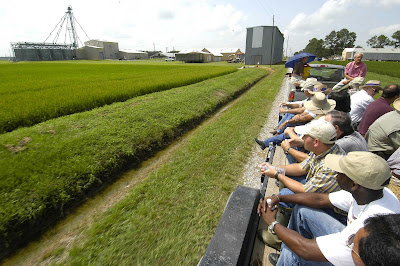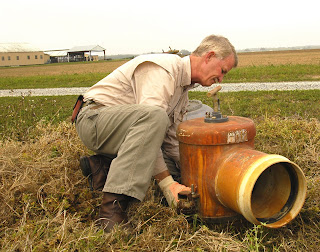 The final numbers are in for the harvest of the blog field. The picture above shows the field after the rice was cut.
The final numbers are in for the harvest of the blog field. The picture above shows the field after the rice was cut.Larry White determined the overall yield was 46.26 barrels per acre at 18.5 percent moisture. That will be 42.8 barrels after the rice is dried in bins to 12 percent moisture.
In South Louisiana, rice is measured in barrels. A barrel is 162 pounds of rice.
North Louisiana farmers measure rice by the bushel. A total of 45 pounds is contained in 1 bushel, and that works out ot .277 of a barrel. One barrel contains 3.6 bushels.
But rice also is measured in hundredweights (100 pounds of rice = 1 hundredweight).
Meanwhile, several other fields at the station have been harvested while others are not mature enough for harvest. Some varieties mature earlier than others. Farmers generally prefer an earlier harvest to avoid the peak of hurricane season in late August and early September.














 Florets open to allow pollination generally between 10 a.m. and 2 p.m. This can vary depending on environmental conditions mostly associated with temperature and humidity. Under cloudy, cool, calm or humid conditions, the time for pollination may shift later by as much as an hour or so.
Florets open to allow pollination generally between 10 a.m. and 2 p.m. This can vary depending on environmental conditions mostly associated with temperature and humidity. Under cloudy, cool, calm or humid conditions, the time for pollination may shift later by as much as an hour or so.


































